The Trees are Withering
There is a war going on.
On one side are trees. And on the other... semilattices.
Trees vs Semilattices
One of the earliest reports came from the urban design front, from a certain Christopher Alexander who has been surprisingly influential outside his fields of architecture and design. For instance, the idea of design patterns in programming was inspired by his work.
In his seminal paper A City is not a Tree he uses the concepts of trees and semilattices to explain why centrally designed high modernist cities end up awful to live in.
It should be obvious that we aren't talking about the trees found in nature. The trees and semilattices here are mathematical names for different ways of arranging things into a larger whole. Equivalently, you can also think of them as different kinds of graphs.
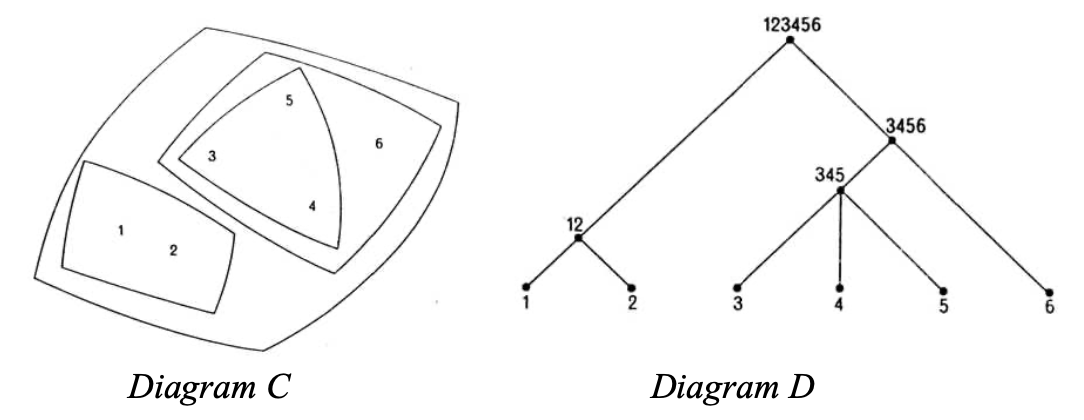
(Examples of trees from ‘A City is not a Tree’)
A tree is a graph where each node has only one parent node. Drawn as sets there are no overlaps.
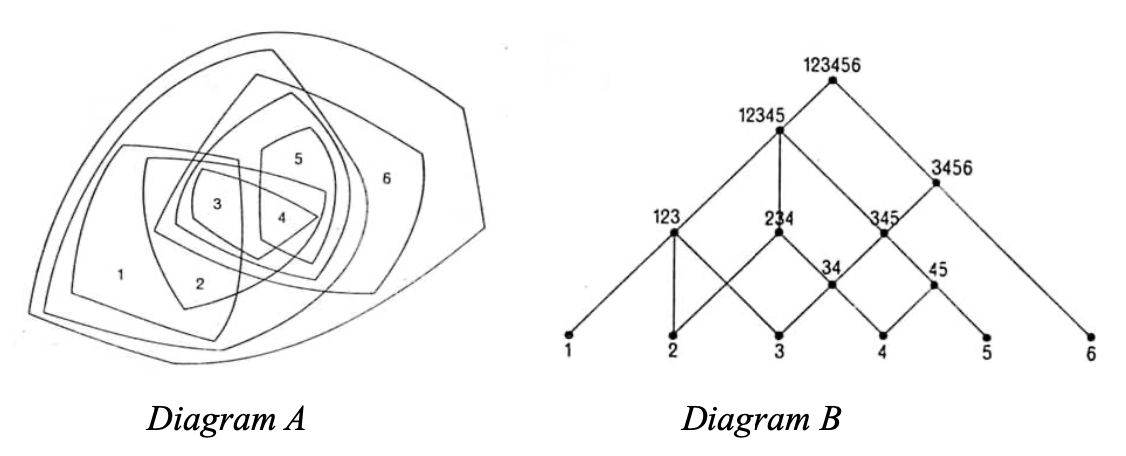
In contrast, semilattices are graphs which don't have that restriction1. Look at the overlapping groupings in the diagram.
Can a thing be part of more than one group? If yes, you are dealing with a semilattice, otherwise with a tree.
Physical arrangements are trees. A thing cannot be in two places at the same time.
Abstractions usually form semilattices. A concept can be a part of multiple fields.
The Persistence of Trees
Grouping and categorization are among the most primitive psychological processes and humans have a much easier time using trees to do that.
We always want to put things in boxes. One item in one box. We are far too eager to reduce the complexity of a person into some or the other label. And just as we cannot put a thing into more than one box, our minds have a far easier time putting abstractions into just one category too.
This even extends to visual perception. There are studies where patterns with overlapping units were shown to people, but when asked to recall the patterns they almost always invented a tree representation.
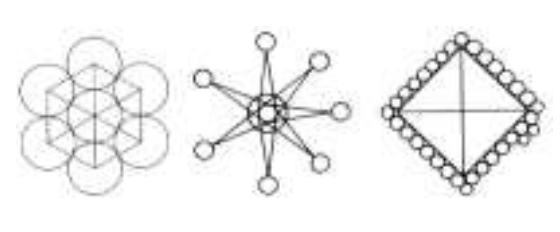
(The original is on the left. Two typical redrawn versions on right. The overlaps disappear during recall. From ‘A City is not a Tree.')
When faced by a complex organization, we tend to reorganize it in terms of non-overlapping units. Unlike its more familiar natural namesake these trees aren’t grown, they are constructed, to exorcise complexity.
Whenever we have a tree structure, it means that within this structure no piece of any unit is ever connected to other units, except through the medium of that unit as a whole.
The enormity of this restriction is difficult to grasp. It is a little as though the members of a family were not free to make friends outside the family, except when the family as a whole made a friendship.
In simplicity of structure the tree is comparable to the compulsive desire for neatness and order that insists the candlesticks on a mantelpiece be perfectly straight and perfectly symmetrical about the centre. The semilattice, by comparison, is the structure of a complex fabric; it is the structure of living things, of great paintings and symphonies.
– A City is not a Tree, Christopher Alexander
This instinctual blindness towards overlapping structures leads us to conceive of systems like cities as trees. None of that changes the fact that the real world is full of messy semilattices. The paper talks about how this hampers the design of cities, and how artificial cities which were centrally planned are less livable and walkable than natural cities which evolved on their own leading to rich semilattices with overlapping purposes.
This is not just about cities, though. So many things that look different on the surface are actually trees.
A bullet list is a tree with items under headings.
A book is a tree with sections under chapters.
A mind map looks different from a list, but that's just cosmetics, it's as good as a bullet list.
A MECE list is tree by definition, mutually exclusive means there are no overlaps.
Hierarchies are trees.
The folder structure on your computer is a tree.
Designers talk of skeuomorphism in interfaces. This is a more insidious form of it: It is skeuomorphism in the UI of thought. There is no need of defaulting to trees when dealing with non-physical things that can be in more than one place.
To think digital is to break free of trees when it makes sense.
The Resistance of Semilattices
A lot of innovations in diverse areas are the semilattices fighting back.
Yahoo vs Google
Yahoo, faced with digital shelves, tried to build familiar hierarchies back in.
Unsurprisingly, the categorization often ran into weird edge cases. For instance, are booksellers a subset of books or of businesses? While it was shown under books, the @ at the end denotes that it should have been somewhere else.
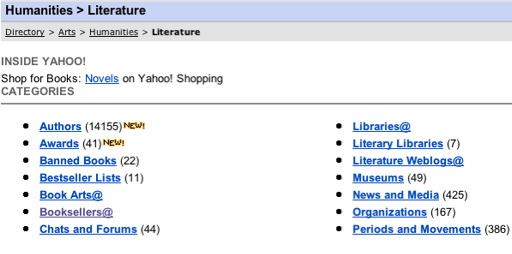
(Hierarchical classification issues. Ontology is Overrated, Clay Shirky)
Google, on the other hand, accepted the hyperlinked pages as it is, and developed a graph theory based algorithm.
Hierarchy vs Holacracy
Traditional org-charts are trees.

Matrix organizations destroy the tree by adding reporting links across the branches.
Then there’s Holacracy which uses the concept of circles of roles where a person can fill multiple roles. Overlaps. Some illustrations look just like the semilattice diagrams above.
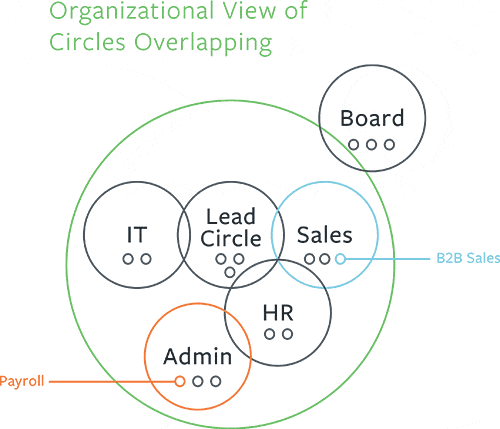
( How Light Holacracy Transformed Our Startup, Blinkist)
Folders, Tags, Links
File Systems
Folder structures are trees. Folders inside folders, files in one place only. More generally the most basic form of any information grouping are trees.
But there is some pushback. Depending on your OS there are options to tag files, and create symbolic links, thereby destroying the trees.
Evernote, Roam, Obsidian
Different note-taking software have different inclinations about how to organize your notes.
Evernote leans towards the folders and tags. Notebooks collected into stacks to build the tree, and tags to reach across the branches. Roam is all about links. And Obsidian has all three.
Monoliths vs Microservices
Software architectures have been evolving towards microservices from the monoliths.
Monoliths are tree-like. Components are integrated into a single top level node.
Microservices are not. Components settle into a network of interconnected functionalities.

( Microservices vs Monolithic architecture)
A Grook is not a Tree
(Unlike groot.)
A while back I had written about shapes of books and about a different format for non-narrative books. Let’s call them grooks2 (short for graph-books) because things need names.
A grook is a revolt against trees.
Concepts and stories don’t fit neatly into boxes within boxes. They relate to more than one thing.
Physical books (you know, dead-tree ones) need to live with this limitation. The only way out is through repeating segments in various places. You will notice certain example-stories being returned to various times in a nonfiction book.
Digital books no longer need to play by these rules. They don’t need to squash the semilattice into a legible tree. The ease of reaching an idea from another can be proportional to how related they are.
They can be grooks. More livable, more walkable books.
Anyway, it seems that the trees are withering. And maybe that’s a good thing.
Technically trees are a special case of semilattices but we are more concerned with the difference of the structures where overlaps are allowed and those where they aren’t. ↩︎
Roam-native/obsidian-native books sound clunky. rBooks and oBooks are alright, but a concept’s name shouldn’t be so tied up with the material it’s implemented on. A book is a book whether its pages are glossy or not. And I like that grook is so close to grok, since the point is grokking things better. I also like that there is an enjoyable poetic form called grook. ↩︎